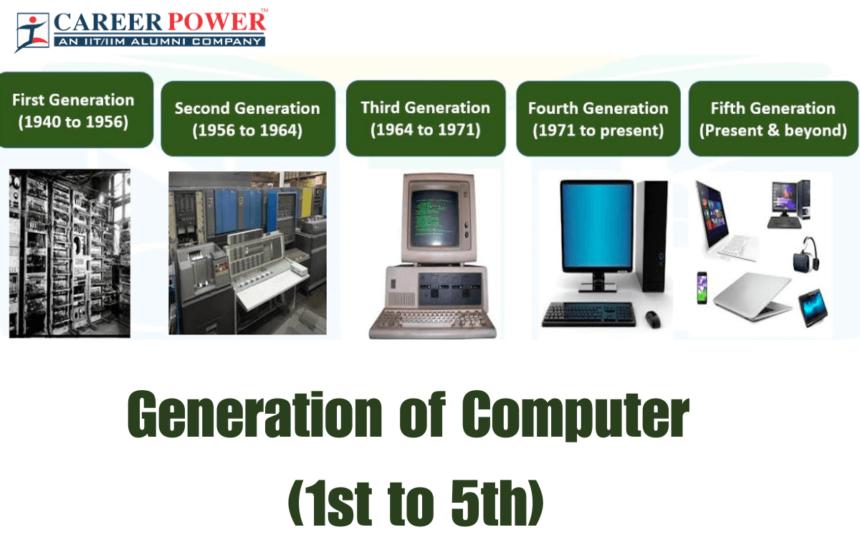What is computer generation?
A computer generation refers development and accumulation of computer technology over the years. Computers have gone through five (5) stages during their development each generation is characterized by dramatic improvements in;
- Technology to build the computer
- Internal organization of the computer
- Programming languages used.
- The physical setup of computer i.e. the size
- Increase in performance capabilities
- The setback of the computers
FIRST COMPUTER GENERATION (1946 – 1956: vacuum tube)
Technological innovations
Vacuum tubes which were used for power distribution and internal operations
Magnetic drums which were used for storage
Punched cards for input and output
Characteristics of first computer generation
They had limited primary memory, a maximum of 2000bytes (2KB) of RAM
Programming was done in machine code.
They had a speed of 10 kilo instructions per second.
They consumed a lot of power.
They gave off a lot of heat.
They were very expensive
They had maintenance problems and needed a stand by technician.
They were very heavy (about 30tons)
They were very big (almost of a size of a room)
They had no operating system.
Examples of first computer generation
ENIAC (Electronic Numeric Integrator and Computer)
UNIVAC (Universal Automatic Computer)
EDVAC (Electronic Discrete Variable Automatic Computer)
IBM 650 (International Business Machine)
SECOND COMPUTER GENERATION (1957 – 1963: Transistor)
Technological innovations
Transistors which were used for power distribution and internal operations
Magnetic core memories for storage
High level programming languages such as FORTRAN (Formula Translation, COBOL (Common Business Oriented Language)
Super computers such as LARC and IBM 7030
Characteristics of second computer generation
Speed of operation increased to 200,000 – 300,000 instructions per second.
They generated less heat and consumed less power compared to their predecessors.
They became more reliable compared to the first generation computers.
The computers became smaller in size.
Computers became less expensive.
They had no operating system.
The primary memory increased to 32KB of RAM
Examples of second computer generation
• NCR 501
• CDC – 6600 mainframe computer
• IBM 7030
• TRADIC
• IBM 7030
• LARC (Livermore Atomic Research Computer)
THIRD COMPUTER GENERATION (1964 – 1979: Integrated circuits)
Technological innovations
Integrated Circuits (ICs) for power distribution and internal operations
ICs were made by combining several transistors onto a single chip
Magnetic disks for storage
Production of the first mini computers
Introduction of the first operating systems
Characteristics of third generation computers
Introduction of simple programming languages like BASIC (Beginners All purpose Symbolic Instruction Code)
Computers greatly reduced in size compared to their predecessors.
Computers became reliable, smaller in size, cheap and consumed little power which made them popular.
The keyboards and monitors replaced punched cards for input and output.
Magnetic hard disks were developed for storage purposes
Memory size expanded to approximately 2 megabytes of RAM
Speed increased to 5 million instructions per second
Integrated Circuits consumed a lower electric power.
The noise produced by the computers reduced drastically
Examples of third computer generation
IBM 360 series
IBM 370
PDP-11
8-bit microcomputers
FOURTH COMPUTER GENERATION (1979-1989: Microprocessor)
Technological innovations
Development of the Large Scale Integration Circuits and Very Large Integration Circuits which led to the invention of microprocessor
Development of the first microcomputers
Characteristics of fourth generation computer
Introduction of microprocessor that led to the development of micro and mini computers
Introduction of 404 Intel chip
Primary memory increased in size to 128MB of RAM
The speed accelerated to 50 million instructions per second
Computers became more powerful and cheap
Introduction of robotic technology
There was limited artificial intelligence and expert system
Introduction of a wide variety of software
Development of programming languages which are easy to use which resemble human languages like C, C+, C++ etc.
Direct use of input and output devices like keyboards, mice etc to provide a more natural user interface
Examples of fourth computer generation computers
• Mainframe computers such as; IBM308, and Amdah580
• Computers with processors 8088, 802886, 80386
• Apple Macintosh
FIFTH COMPUTER GENERATION (1990 – Present: Artificial intelligence)
Technological innovations
Use of artificial intelligence
Production of Robots
Characteristics of fifth computer generation computers
Development of powerful and intelligent computers with the ability to see, listen, talk and think started.
Innovation of biometric systems
Development of wireless communication
Increased use of wireless communication through the use of mobile phones
Computer hardware and software costs and sizes decreased drastically.
Development of networking technologies
Emerging telecommunication and computing technology
Use of Very large microprocessor circuits in parallel processing
Use of highly sophisticated operating systems
Innovation of CCTV for security purposes
Introduction of flash memory for data storage
Use of robots most especially in industries
Artificial Intelligence is a group of related technologies that attempt to develop machines to emulate human like qualities such as learning, reasoning, communicating, seeing and hearing.







